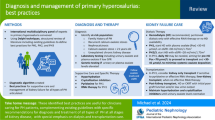Abstract
Background
Reactive oxygen species are as being related to the pathophysiology of endstage renal disease (ESRD). We measured the plasma hydroxyl radical (·OH)-producing ability and ·OH-scavenging activity in patients with ESRD to clarify the pathophysiological states involved.
Methods
We used electron spin resonance to measure plasma N-t-butyl-α-phenylnitron radical spin adduct (pPBN rsa) as ·OH-producing ability and plasma 3,3,5,5-tetramethyl-1-pyrroline-N-oxide radical spin adduct (pM4PO rsa) as ·OH-scavenging activity. Oxidative injuries were evaluated by determining oxidised low-density lipoprotein (Ox-LDL).
Results
The pPBN rsa of the ESRD patients was lower than that of the controls (1.83 vs 2.94 µmol/g protein). The pM4PO rsa of the ESRD patients was higher than that of the controls (3.85 vs 3.15 mmol l-ascorbic acid 2-[3,4-dihydro-2,5,7,8-tetramethyl-2-(4,8,12-trimethyltridecyl)-2H-1-benzopyran-6-yl hydrogen phosphate] potassium salt (EPC-K1)/g protein). The pPBN rsa and pM4PO rsa were correlated, both in the ESRD patients and in the controls (r = 0.47 and r = 0.53). Ox-LDL was correlated with hemodialysis (HD) duration (r = 0.49) and was negatively correlated with pPBN rsa (r = −0.54), which indicates that oxidative stress was increased as HD therapy was prolonged and suppressed pPBN rsa.
Conclusions
There was an imbalance between ·OH-producing ability and ·OH-scavenging activity, in the ESRD patients, and this may be responsible for compromising the health of ESRD patients.
Similar content being viewed by others
References
T Shimazu M Ominato K Toyama T Yasuda T Sato T Maeba et al. (2001) ArticleTitleEffects of a vitamin E-modified dialysis membrane on neutrophil superoxide anion radical production Kidney Int Suppl 78 S137–43 Occurrence Handle1:CAS:528:DC%2BD3MXhtlKjtLc%3D Occurrence Handle10.1046/j.1523-1755.2001.59780137.x Occurrence Handle11168999
JB Schulz DR Henshaw U MacGarvey MF Beal (1996) ArticleTitleInvolvement of oxidative stress in 3-nitropropionic acid neurotoxicity Neurochem Int 29 167–71 Occurrence Handle1:CAS:528:DyaK28Xks1Khtrw%3D Occurrence Handle10.1016/0197-0186(95)00122-0 Occurrence Handle8837046
MT Grijalba PB Andrade AR Meinicke RF Castilho AE Vercesi S Schreier (1998) ArticleTitleInhibition of membrane lipid peroxidation by a radical scavenging mechanism: a novel function for hydroxyl-containing ionophores Free Radic Res 28 301–18 Occurrence Handle1:CAS:528:DyaK1cXksFSns7c%3D Occurrence Handle10.3109/10715769809069282 Occurrence Handle9688216
EG Janzen Y Kotake RD Hinton (1992) ArticleTitleStabilities of hydroxyl radical spin adducts of PBN-type spin traps Free Radic Biol Med 12 169–73 Occurrence Handle1:CAS:528:DyaK38Xlt1GqtLs%3D Occurrence Handle10.1016/0891-5849(92)90011-5 Occurrence Handle1313775
GM Rosen MJ Turner Suffix3rd (1988) ArticleTitleSynthesis of spin traps specific for hydroxyl radical J Med Chem 31 428–32 Occurrence Handle1:CAS:528:DyaL1cXlsFyisA%3D%3D Occurrence Handle10.1021/jm00397a028 Occurrence Handle2828624
JW Heinecke M Kawamura L Suzuki A Chait (1993) ArticleTitleOxidation of low density lipoprotein by thiols: superoxide-dependent and -independent mechanisms J Lipid Res 34 2051–61 Occurrence Handle1:CAS:528:DyaK2cXntFSlsw%3D%3D Occurrence Handle8301226
DA Stoyanovsky Z Melnikov AI Cederbaum (1999) ArticleTitleESR and HPLC-EC analysis of the interaction of hydroxyl radical with DMSO: rapid reduction and quantification of POBN and PBN nitroxides Anal Chem 71 715–21 Occurrence Handle1:CAS:528:DyaK1cXotVSrs7c%3D Occurrence Handle10.1021/ac980657r Occurrence Handle9989388
AE Dikalova MB Kadiiska RP Mason (2001) ArticleTitleAn in vivo ESR spin-trapping study: free radical generation in rats from formate intoxication – role of the Fenton reaction Proc Natl Acad Sci USA 98 13549–53 Occurrence Handle1:CAS:528:DC%2BD3MXovVyns70%3D Occurrence Handle10.1073/pnas.251091098 Occurrence Handle11717423 Occurrence Handle61078
CM Shen SJ Mao GS Huang PC Yang RM Chu (2001) ArticleTitleStimulation of smooth muscle cell proliferation by ox-LDL- and acetyl LDL-induced macrophage-derived foam cells Life Sci 70 443–52 Occurrence Handle1:CAS:528:DC%2BD38XhtVSntrg%3D Occurrence Handle10.1016/S0024-3205(01)01428-X Occurrence Handle11798013
A Ichihara M Hayashi N Hirota T Saruta (2001) ArticleTitleSuperoxide inhibits neuronal nitric oxide synthase influences on afferent arterioles in spontaneously hypertensive rats Hypertension 37 630–4 Occurrence Handle1:CAS:528:DC%2BD3MXhvVSlt7g%3D Occurrence Handle10.1161/01.HYP.37.2.630 Occurrence Handle11230347
H Mori T Arai K Mori H Tsutsui K Makino (1994) ArticleTitleUse of M4PO and oxygen-17 in the study on hydroxyl radical generation in the hypoxanthine-xanthine oxidase reaction Biochem Mol Biol Int 32 523–9 Occurrence Handle1:CAS:528:DyaK2cXlt1ymt7Y%3D Occurrence Handle8032319
MJ Burkitt (1993) ArticleTitleESR spin trapping studies into the nature of the oxidizing species formed in the Fenton reaction: pitfalls associated with the use of 5,5-dimethyl-1-pyrroline-N-oxide in the detection of the hydroxyl radical Free Radic Res Commun 18 43–57 Occurrence Handle1:CAS:528:DyaK3sXms1Gks7w%3D Occurrence Handle10.3109/10715769309149912 Occurrence Handle8394273
K Okamoto H Tanaka Y Makino I Makino (1998) ArticleTitleRestoration of the glucocorticoid receptor function by the phosphodiester compound of vitamins C and E, EPC-K1 (L-ascorbic acid 2-[3,4-dihydro-2,5,7,8-tetramethyl-2-(4,8,12-trimethyltridecyl)-2H-1-benzopyran-6-yl hydrogen phosphate] potassium salt), via a redox-dependent mechanism Biochem Pharmacol 56 79–86 Occurrence Handle1:CAS:528:DyaK1cXksFanur8%3D Occurrence Handle10.1016/S0006-2952(98)00121-X Occurrence Handle9698091
T Wei C Chen F Li B Zhao J Hou W Xin A Mori (1999) ArticleTitleAntioxidant properties of EPC-K1: a study on mechanisms Biophys Chem 77 153–60 Occurrence Handle1:CAS:528:DyaK1MXitlGqu70%3D Occurrence Handle10.1016/S0301-4622(99)00017-4 Occurrence Handle10326248
NE Polyakov TV Leshina TA Konovalova LD Kispert (2001) ArticleTitleCarotenoids as scavengers of free radicals in a Fenton reaction: antioxidants or pro-oxidants? Free Radic Biol Med 31 398–404 Occurrence Handle1:CAS:528:DC%2BD3MXlt1Smtrk%3D Occurrence Handle10.1016/S0891-5849(01)00598-6 Occurrence Handle11461778
GR Buettner (1987) ArticleTitleSpin trapping: ESR parameters of spin adducts Free Radic Biol Med 3 259–303 Occurrence Handle1:CAS:528:DyaL1cXhvVGltg%3D%3D Occurrence Handle10.1016/S0891-5849(87)80033-3 Occurrence Handle2826304
I Ueno M Kohno K Mitsuta Y Mizuta S Kanegasaki (1989) ArticleTitleReevaluation of the spin-trapped adduct formed from 5,5-dimethyl-1-pyrroline-1-oxide during the respiratory burst in neutrophils J Biochem (Tokyo) 105 905–10 Occurrence Handle1:CAS:528:DyaL1MXksFGgs7k%3D Occurrence Handle10.1093/oxfordjournals.jbchem.a122777
P Kuppusamy JL Zweier (1989) ArticleTitleCharacterization of free radical generation by xanthine oxidase. Evidence for hydroxyl radical generation J Biol Chem 264 9880–4 Occurrence Handle1:CAS:528:DyaL1MXksleksbg%3D Occurrence Handle2542334
S Hippeli U Rohnert D Koske EFO Elstner (1997) ArticleTitleH-radical-type reactive oxygen species derived from superoxide and nitric oxide: a sensitive method for their determination and differentiation Z Naturforsch [C] 52 564–70 Occurrence Handle1:CAS:528:DyaK2sXntVahtb8%3D
Author information
Authors and Affiliations
Corresponding author
About this article
Cite this article
Shirai, S., Ominato, M., Shimazu, T. et al. Imbalance between production and scavenging of hydroxyl radicals in patients maintained on hemodialysis. Clin Exp Nephrol 9, 310–314 (2005). https://doi.org/10.1007/s10157-005-0374-7
Received:
Accepted:
Published:
Issue Date:
DOI: https://doi.org/10.1007/s10157-005-0374-7




